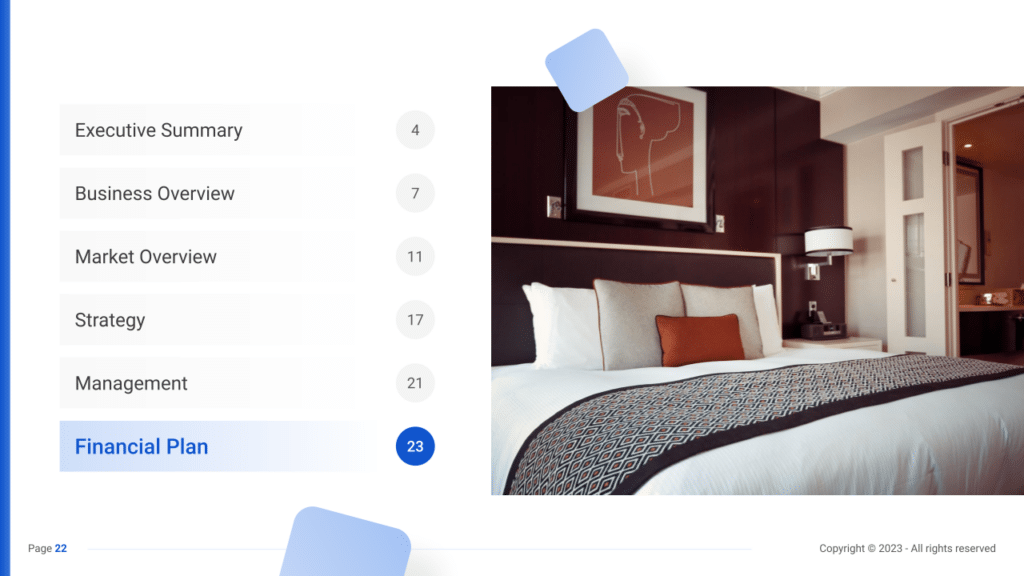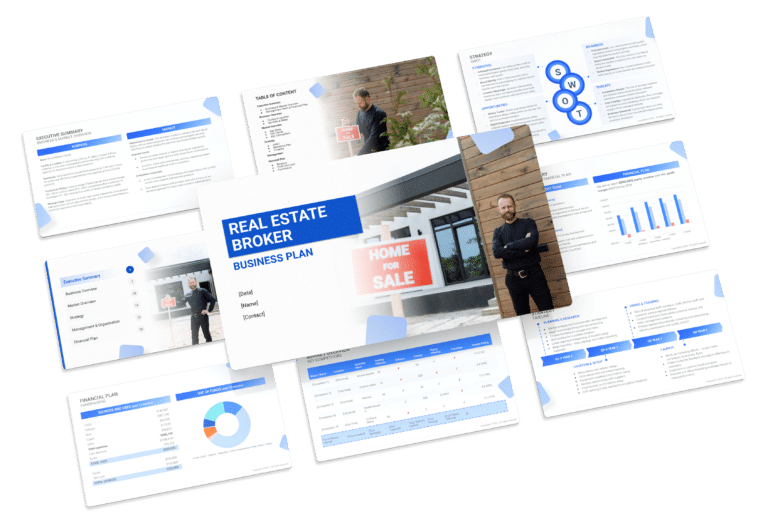Hotel Restaurant Business Plan Template & PDF Example
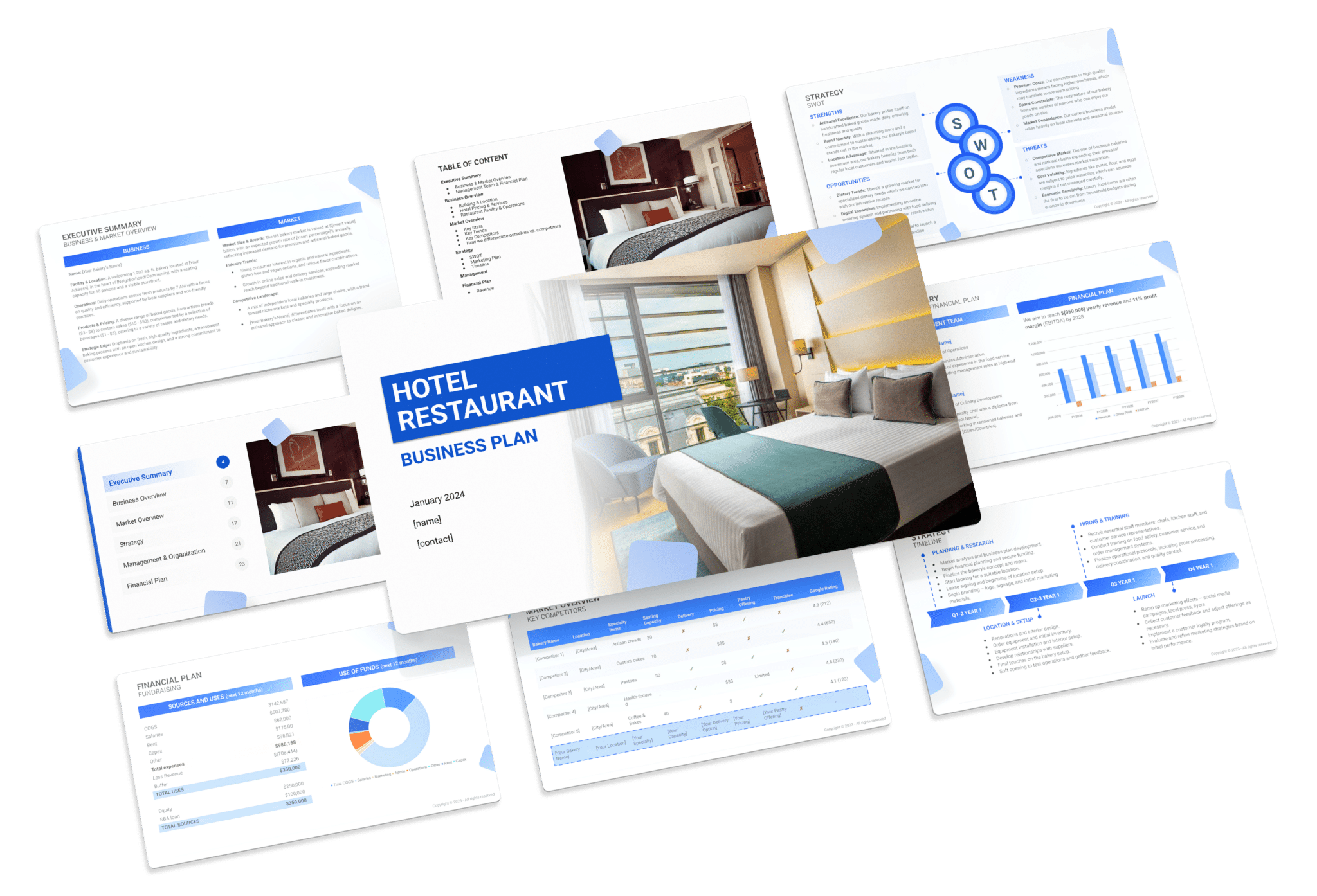
Creating a comprehensive business plan is crucial for launching and running a successful hotel restaurant. This plan serves as your roadmap, detailing your vision, operational strategies, and financial plan. It helps establish your hotel restaurant’s identity, navigate the competitive market, and secure funding for growth.
This article not only breaks down the critical components of a hotel restaurant business plan, but also provides an example of a business plan to help you craft your own.
Whether you’re an experienced entrepreneur or new to the real estate industry, this guide, complete with a business plan example, lays the groundwork for turning your hotel restaurant concept into reality. Let’s dive in!
The Plan
Our Hotel Restaurant Business Plan is designed to cover all critical aspects for a comprehensive strategy. It outlines the hotel’s unique offerings, market position, competitive edge, management expertise, and financial goals.
- Executive Summary: Offers an overview of the hotel restaurant’s business concept, market analysis, management, and financial strategy.
- Business Overview: Provides detailed information on what the hotel restaurant offers and its operational model:
- Building & Location: Describes the hotel’s prime location, architecture, and why it’s appealing to potential guests.
- Hotel Pricing & Services: Lists the room options, amenities, and additional services such as spa and concierge.
- Restaurant Facility & Operations: Details the restaurant’s layout, capacity, and operational approach.
- Market Overview: Examines the hotel and restaurant industry landscape, identifying competitors and how the hotel restaurant stands out:
- Key Stats: Shares industry size, growth trends, and relevant statistics for the hotel and restaurant market.
- Key Trends: Highlights recent trends affecting the hospitality sector, like sustainability and technology integration.
- Key Competitors: Analyzes main competitors in the area and how the hotel restaurant offers a unique experience.
- Strategy: Outlines how the hotel restaurant intends to achieve growth and attract guests:
- SWOT: Strengths, weaknesses, opportunities, and threats analysis.
- Marketing Plan: Strategies for promoting the hotel and restaurant to attract and retain guests.
- Timeline: Key milestones and objectives from planning through the first year of operation.
- Management: Information on who manages the hotel restaurant and their roles.
- Financial Plan: Projects the hotel restaurant’s financial performance, including revenue, profits, and expected expenses.

Executive Summary
The Executive Summary introduces your hotel restaurant’s business plan, providing a concise overview of the restaurant and its offerings. It should detail your market positioning, the range of culinary experiences and dining services you offer, its location within the hotel, ambiance, size, and an outline of day-to-day operations.
This section should also explore how your hotel restaurant will integrate into the local dining scene, including the number of direct competitors within the area, identifying who they are, along with your restaurant’s unique selling points that differentiate it from these competitors.
Furthermore, you should include information about the management and co-founding team, detailing their roles and contributions to the restaurant’s success. This could include the head chef’s culinary background, the restaurant manager’s hospitality experience, and other key personnel. Additionally, a summary of your financial projections, including revenue and profits over the next five years, should be presented here to provide a clear picture of your restaurant’s financial plan. This will help potential investors understand the growth potential and financial viability of your hotel restaurant.
Hotel Restaurant Business Plan Executive Summary Example

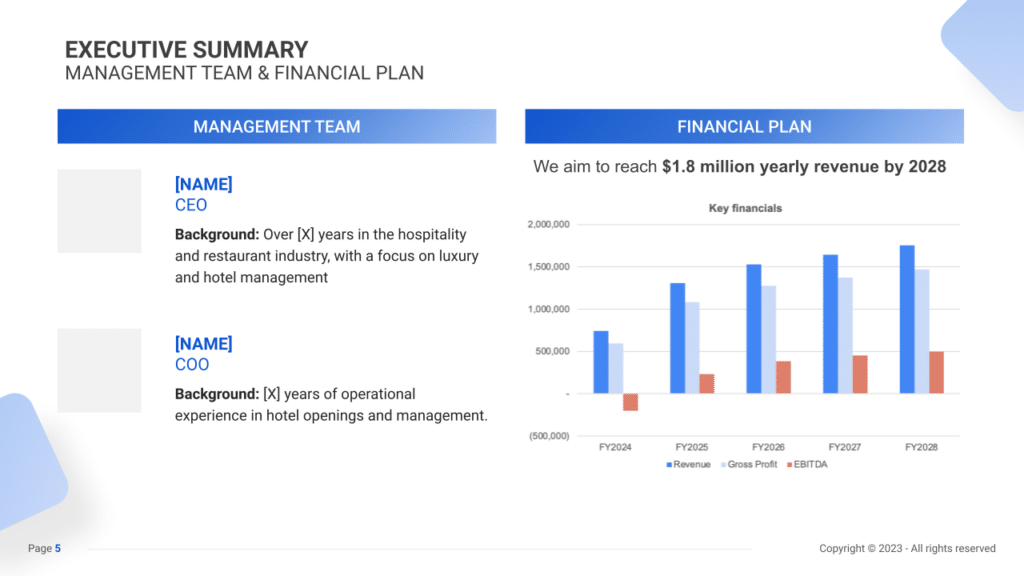
Business Overview
The business overview should clearly define the key aspects of your hotel restaurant, including its unique room designs, high-quality dining experience, wellness facilities, and event hosting services. Emphasizing what sets your establishment apart in a competitive hotel market is crucial for attracting interest and investment.
Example:
“EliteStay Hotel Restaurant” in Downtown Metropolis offers a luxurious and intimate setting with 50 uniquely designed rooms. The on-site restaurant focuses on gourmet cuisine made with locally sourced ingredients, creating a unique dining journey for guests. Additional amenities include a full-service spa, a modern fitness center, and versatile event spaces tailored for weddings and conferences, making it an all-encompassing destination for discerning travelers.
Market Overview
This section should analyze the hotel market’s size, growth trends, consumer preferences, and competitive landscape. It positions your hotel restaurant within the industry and highlights its potential to meet the evolving demands for sustainable, culturally immersive lodging experiences.
Example:
EliteStay Hotel Restaurant enters a US hotel market worth $243 billion. While the area features several established hotels, there’s a notable gap for boutique establishments offering unique experiences like EliteStay. With consumer trends shifting towards sustainable and immersive lodging, the hotel is well-positioned to attract eco-conscious and culturally inclined guests, particularly millennials.
Management Team
Detailing the management team’s background and roles is vital. This part of the summary should emphasize their experience in luxury hospitality and restaurant management, underscoring their ability to ensure the hotel’s operational excellence and high-quality guest services.
Example:
The CEO of EliteStay Hotel Restaurant, with over 20 years in the luxury hospitality sector, leads the hotel’s strategic direction and ensures exceptional guest experiences. The COO, with extensive operational experience in hotel openings, oversees the day-to-day management, ensuring smooth operations and maintaining the highest standards of service.
Financial Plan
Clearly outlining the financial goals and projections is key. This section should include revenue targets and EBITDA margins, providing insight into the hotel’s financial health and growth prospects.
Example:
EliteStay Hotel Restaurant aims to achieve $1.8 million in annual revenue by 2028. This financial target is supported by a strategic approach to marketing, focusing on high-end guest services and creating unique, memorable experiences that align with current market trends, positioning the hotel for success in the luxury hospitality market.
Business Overview
For a Hotel Restaurant, the Business Overview section can be effectively divided into 3 main sections:
Building & Location
Describe the restaurant’s ambiance and design, focusing on how it complements the hotel’s theme and enhances the dining experience. Mention the restaurant’s location within the hotel, highlighting its accessibility to both hotel guests and outside patrons. Emphasize features such as scenic views, outdoor seating, or unique architectural elements that set the dining atmosphere apart. Explain why this location is beneficial for attracting your target demographic, including hotel guests, local diners, and tourists.
Hotel Pricing & Services
Outline the range of dining options and services offered, from breakfast buffets and à la carte menus to special themed dining evenings or room service options. Discuss your pricing strategy, ensuring it aligns with the hotel’s positioning and the value of the culinary experience provided. Highlight any special packages, such as dining credits included in hotel stays, happy hour deals, or seasonal promotions that add value for hotel guests and encourage local patronage.
Restaurant Facility & Operations
Provide details on the operational aspects of the restaurant, including kitchen facilities, seating capacity, and any private dining or event spaces available. Discuss the restaurant’s service model, whether it’s casual dining, fine dining, or a specific theme or cuisine focus. Mention any sustainable practices or local sourcing initiatives in place to appeal to eco-conscious diners. Describe how the restaurant’s operations are designed to ensure high-quality service and memorable dining experiences for every guest.

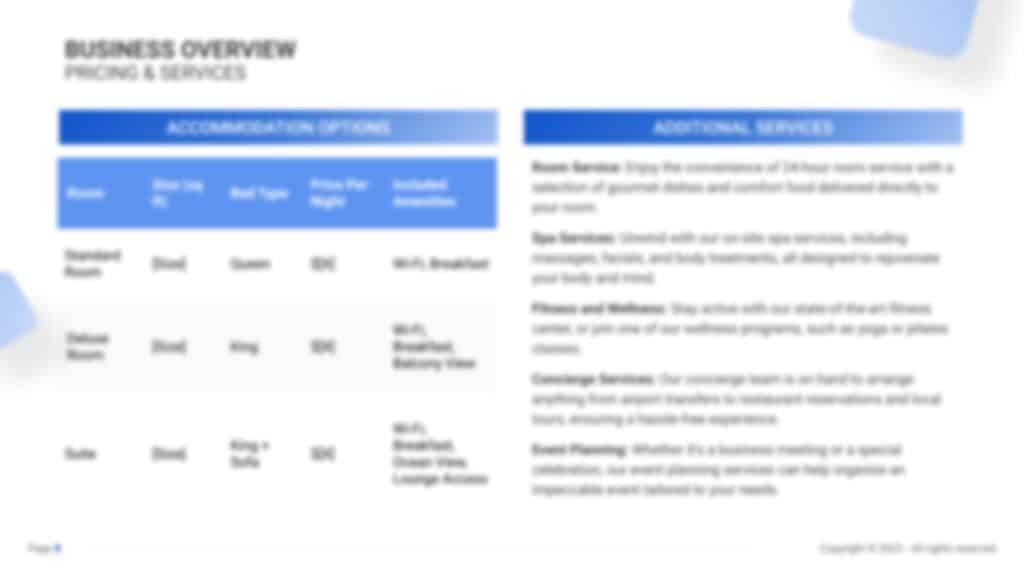
Market Overview
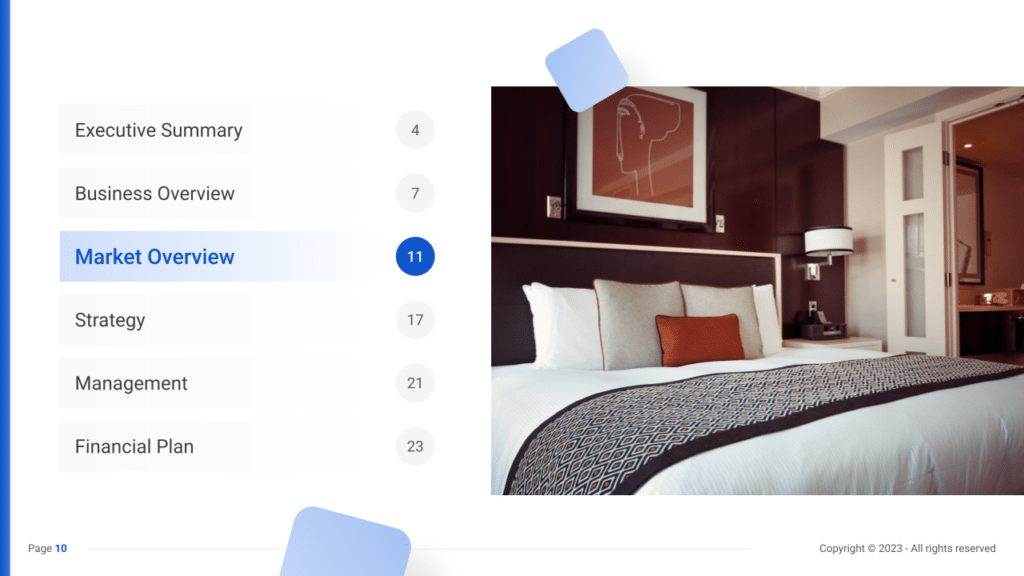
Industry Size & Growth
In the Market Overview of your hotel restaurant business plan, begin by examining the size of the restaurant industry within the hospitality sector and its growth prospects. This analysis is essential for grasping the market’s breadth and pinpointing potential areas for expansion.
Key Market Trends
Move on to discuss recent trends in the dining industry, such as the growing consumer interest in farm-to-table dining experiences, international cuisines, and health-conscious menus. For instance, spotlight the demand for dining experiences that offer not just meals but culinary journeys, with a focus on locally sourced ingredients, dietary variety, and innovative cooking methods. The trend towards sustainability in the food industry, including waste reduction and eco-friendly practices, should also be highlighted.
Competitive Landscape
A competitive analysis is not just a tool for gauging the position of your hotel restaurant in the market and its key competitors; it’s also a fundamental component of your business plan.
This analysis helps in identifying your hotel restaurant’s unique selling points, essential for differentiating your business in a competitive market.
In addition, competitive analysis is integral in laying a solid foundation for your business plan. By examining various operational aspects of your competitors, you gain valuable information that ensures your business plan is robust, informed, and tailored to succeed in the current market environment.
Identifying Your Competitors in the Hotel Restaurant Industry
Initiate the competitive analysis by delineating the local dining landscape. Identify rival hotel restaurants within your vicinity, upscale standalone eateries, and even food establishments within hotels that aren’t direct competitors but offer similar dining experiences.
Utilize tools like Google Maps to map out the geographical distribution of these competitors. Online platforms such as Yelp, TripAdvisor, or specialized food review sites provide a wealth of customer feedback and ratings that unveil competitor strengths and weaknesses. For instance, if “Gourmet Haven Hotel Restaurant” consistently receives praise for its fine dining experience and exceptional service, this signifies a significant strength to be considered.
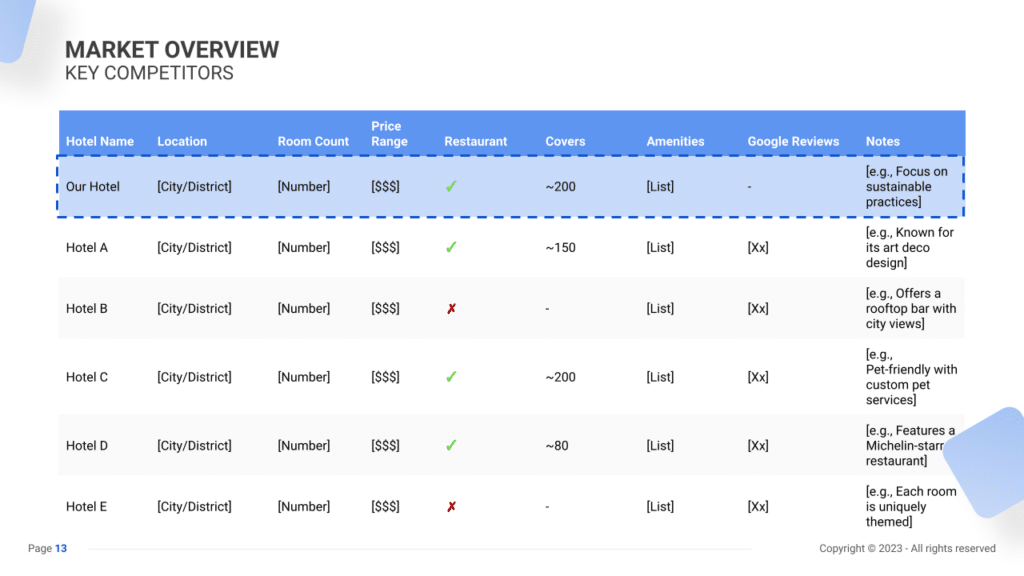
Hotel Restaurant Competitors’ Strategies
Scrutinize the strategies employed by these competitors across various domains:
- Cuisine Offerings: Evaluate the diverse menu offerings. If a nearby hotel restaurant, “Savor Delights,” gains traction with its fusion cuisine or farm-to-table concept, it signals a market trend towards fresh, locally sourced ingredients and innovative culinary styles.
- Dining Experience: Consider the ambiance and service styles. An establishment like “Elegance Eats,” renowned for its sophisticated ambiance and formal dining, might cater to a different clientele compared to a more casual yet trendy restaurant like “Urban Bites.”
- Pricing and Positioning: Analyze pricing strategies. Are your menu prices akin to those of “Affordable Eats Hotel Restaurant” or more aligned with the premium offerings of “Luxury Tastes”?
- Marketing Tactics: Explore the marketing approaches used by competitors. Do they focus on social media campaigns, collaborations with influencers, or perhaps traditional advertising channels?
- Customer Service: Assess the overall dining experience. For instance, “Warm Welcomes Restaurant” might excel in personalized service and creating a homely atmosphere, elevating the diner’s experience.
- Operational Innovations: Observe if competitors leverage technology or innovative practices for efficiency. A hotel restaurant like “Tech Savvy Eats” might stand out for its online reservation system or cutting-edge kitchen technologies.
What’s Your Hotel Restaurant’s Value Proposition
Reflect on the unique value proposition of your hotel restaurant. It could be a specialty dish, a themed dining event, or an emphasis on locally sourced, organic ingredients.
Identify market gaps by gathering feedback from patrons and monitoring industry trends. For instance, a rising demand for eco-friendly dining experiences or an unmet need for globally inspired cuisine could present market opportunities to leverage.
Tailor your restaurant experience based on your location. A hotel restaurant situated in a bustling business district might emphasize quick lunch services or corporate dining, whereas an establishment in a scenic tourist area may highlight leisurely dining experiences with a focus on local flavors and scenic views.
Strategy
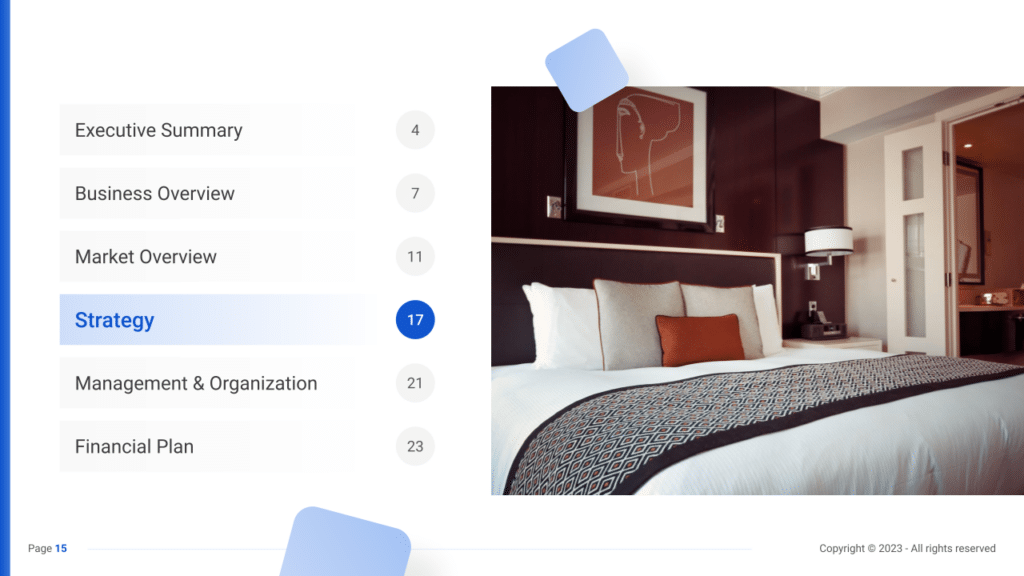
SWOT
Begin with a SWOT analysis for the hotel restaurant, emphasizing Strengths (such as a unique culinary concept and a prime location within the hotel), Weaknesses (including potential high operational costs or stiff competition from local dining establishments), Opportunities (for instance, the growing trend in culinary tourism and interest in unique dining experiences), and Threats (such as economic downturns that may reduce discretionary spending on dining out).
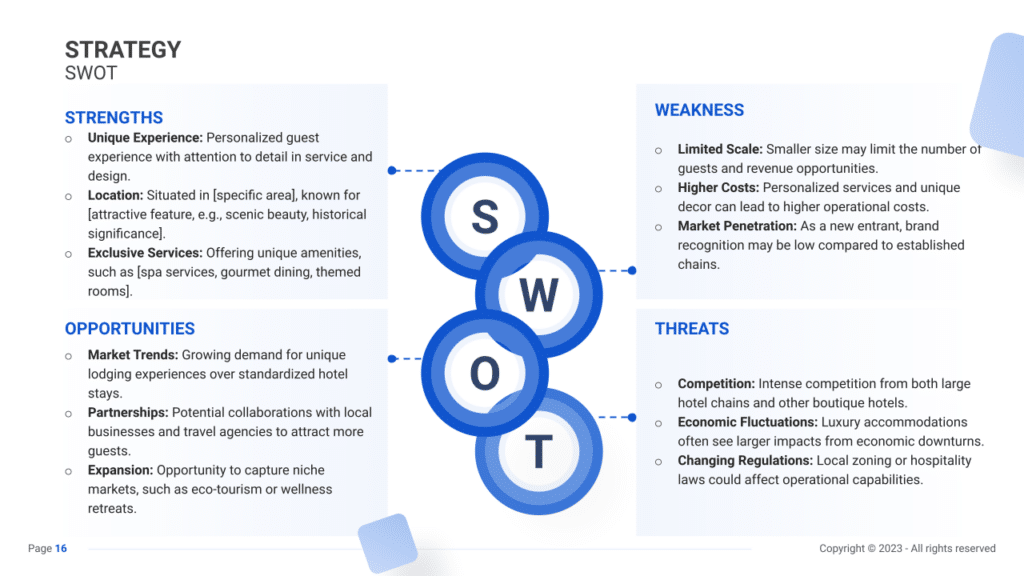
Marketing Plan
Then, formulate a marketing strategy that details how to draw in and keep customers through targeted marketing efforts, special dining promotions, an active and engaging online presence, and involvement in local events and initiatives.
Marketing Channels
Deploying diverse marketing channels is instrumental in disseminating your restaurant’s brand message and attracting patrons.
Digital Marketing Strategies
Leverage the power of digital platforms to engage with your audience:
- Social Media Engagement: Utilize platforms like Instagram, Facebook, Twitter, and TikTok to showcase mouthwatering dishes, chef anecdotes, culinary journeys, and behind-the-scenes glimpses. Engage with your audience through interactive content, polls, and live Q&A sessions.
- Email Marketing Campaigns: Build an email subscriber base by offering incentives like exclusive recipes, chef’s culinary tips, and special event notifications. Send personalized newsletters featuring seasonal menus, chef’s specials, and member-exclusive discounts.
- Website Enhancement& SEO: Maintain an intuitive website featuring appealing visuals, detailed menus, online reservation options, chef profiles, and a blog section highlighting culinary trends, sustainability efforts, or local food partnerships. Optimize your website with relevant keywords, local citations, and customer reviews to enhance visibility in local searches. Utilize Google My Business to ensure accurate information and facilitate customer engagement.
Local Engagement & Collaboration
Forge connections within the local community:
- Community Events: Participate in local food festivals, charity fundraisers, or culinary workshops to integrate with the local food culture and amplify brand visibility.
- Collaborative Ventures: Collaborate with nearby businesses, hotels, event organizers, or tourist attractions for cross-promotions, package deals, or exclusive dining experiences for their patrons.
Promotional Activities
Enticing promotional offers and events is pivotal in attracting new diners while retaining loyal customers.
- Themed Dining Events: Organize themed evenings such as wine-pairing dinners, cultural showcases, seasonal festivals, or chef-hosted culinary masterclasses to create buzz and attract diverse audiences.
- Loyalty Programs: Implement loyalty programs offering tiered benefits, such as priority reservations, chef’s table experiences, birthday rewards, or exclusive invitations to pre-launch tastings.
- Referral Incentives: Encourage patrons to refer friends and family by offering incentives like dining vouchers, complimentary drinks, or exclusive access to limited-menu events.

Sales Channels
Efficient sales channels are pivotal for seamless service delivery and maximizing revenue streams.
In-Restaurant Sales Strategies
Strategically upsell and promote within the restaurant premises:
- Menu Engineering: Employ menu engineering tactics to highlight high-margin items and strategically price dishes to maximize profitability. Train staff in suggestive selling techniques to encourage add-ons or premium selections.
- Special Offers: Introduce limited-time offers, chef’s specials, tasting menus, or seasonal promotions to entice guests to explore diverse menu options and elevate their dining experience.
Online Reservations & E-Commerce
Streamline online reservations and sales processes:
- Efficient Booking Systems: Implement a user-friendly online reservation system integrated into the website and social media platforms. Offer incentives like priority seating or complimentary beverages for online bookings.
- E-Commerce Ventures: Offer select merchandise, chef-curated hampers, or limited-edition culinary experiences for purchase online. Provide contactless pickup or delivery options for added convenience.
Membership & Loyalty Programs
Encourage repeat visits and foster a sense of exclusivity:
- VIP Memberships: Create elite membership tiers offering perks like exclusive events, personalized dining experiences, or early access to new menu launches.
- Point-Based Rewards: Develop a points-based loyalty program where patrons earn redeemable points for every visit, special occasion, or referral, which can be exchanged for discounts, complimentary upgrades, or exclusive invitations.
Strategy Timeline
Lastly, establish a comprehensive timeline that marks key milestones for the hotel restaurant’s launch, promotional activities, customer base development, and growth goals, ensuring the business progresses with clear objectives and intent.

Management
The Management section focuses on the hotel restaurant’s management and their direct roles in daily operations and strategic direction. This part is crucial for understanding who is responsible for making key decisions and driving the hotel restaurant toward its financial and operational goals.
For your hotel restaurant business plan, list the core team members, their specific responsibilities, and how their expertise supports the business.


Financial Plan
The Financial Plan section is a comprehensive analysis of your financial projections for revenue, expenses, and profitability. It lays out your hotel restaurant’s approach to securing funding, managing cash flow, and achieving breakeven.
This section typically includes detailed forecasts for the first 5 years of operation, highlighting expected revenue, operating costs and capital expenditures.
For your hotel restaurant business plan, provide a snapshot of your financial statement (profit and loss, balance sheet, cash flow statement), as well as your key assumptions (e.g. number of customers and prices, expenses, etc.).
Make sure to cover here
_ Profit and Loss
_ Cash Flow Statement
_ Balance Sheet
_ Use of Funds
